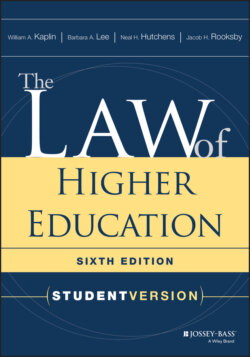Читать книгу The Law of Higher Education - William A. Kaplin - Страница 25
D. The Legal Relationships Within Institutions of Higher Education
ОглавлениеThe internal governance of an institution of higher education (see Section B above) is generally the responsibility of the board of trustees or board of regents (see Section 3.1 of this book). The board, as the entity vested with the institution's legal authority, has legal relationships with the institution's officers, administrators, and staff members; with its faculty members; and with its students. Each relationship encompasses both questions of authority (usually the board's [or institution's] authority) and questions of rights (usually the rights of officers, administrators, and staff, of faculty members, or of students). In turn, there are legal relationships among the institution's officers, administrators, and staff; its faculty members; and its students. These are the three “secondary relationships” depicted in Figure I.3.2 The secondary relationships also encompass both questions of authority and questions of rights. (For an interesting example of such secondary relationships, see Woodruff v. Ohman, 29 Fed. Appx. 337, 162 Ed. Law Rep. 707 (6th Cir. 2002), and 166 Fed. Appx. 212 (6th Cir. 2006) [faculty member/staff member conflict].)
Figure I.3 Internal Legal Relationships in Higher Education Institutions
The three primary legal relationships depicted in Figure I.3 typically are the primary focus of higher education law. Chapters 3 and 4 of the Student Version focus on the legal relationships between the institution (board) and its officers, administrators, and staff. Chapters 5 and 6 focus on the legal relationships between the institution (board) and its faculty; and Chapters 7 through 10 focus on the legal relationship between the institution (board) and students. In addition, the institution has legal relationships with the outside world—for example, with government agencies, private education associations, and corporate research partners and other commercial entities. These external relationships are depicted in Figure I.4 and are addressed in Chapters 11 and 12. For external relationships, as for internal, there are also secondary relationships that may develop between external entities and the institution's officers, administrators, staff, faculty members, or students. For example, a government agency may award a student financial assistance, thus creating a legal relationship between the agency and the student with respect to the conditions for retaining the assistance. These secondary external relationships are not depicted in Figure I.4.
External relationships often intersect with and help define the relationships that are directly depicted in Figure I.4. The rights that faculty members may assert against their institutions (boards), for example, such as rights to nondiscrimination in employment, are created in part by federal law; and the federal government's obligation to enforce this external law (see Section 5.4.1 of this book) creates a legal relationship between the federal government and postsecondary institutions.
In the study of higher education law, it is important to look for these various legal relationships and to sort them out as best one can. Thus, whenever analyzing a judicial opinion or addressing a legal problem, it will be helpful to determine not only what sector of the education law universe is implicated, what governance structure or process is involved, and what source(s) of law applies (see Sections A, B, and C above) but also what legal relationship(s) is at issue and how it helps to define the contours of the dispute.
Figure I.4 External Legal Relationships in Higher Education Institutions
